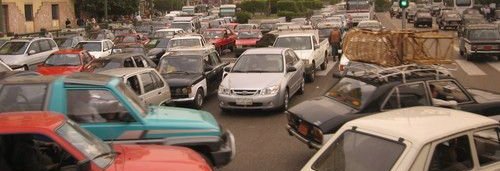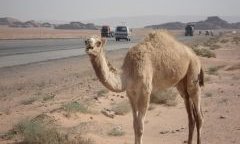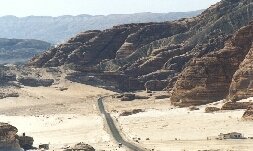If you have the sight of a chameleon (360 degrees), can read minds and have the patience of a saint,
this information might help you through traffic without getting into any accidents.
Driving in Cairo is almost impossible to do if you are not used to driving in Egypt. Just a drive in a taxi in Cairo is quite a thrill and not suitable for people with a heart condition.
Although Egyptian traffic drives on the right side of the road, they use the left side of the road if this section is better, has less speed bumps or if there are camels on the road.
At roundabouts the traffic that drives towards the roundabout gets priority, unless this roundabout is used as a turning point ('U-turn’) or when a big bus is driving on the roundabout. Large buses have or just take right of way everywhere.
The horn is sounded to warn of approach, greet friends, move donkeys, goats, street vendors, pedestrians, children and other road users out of the way and (rarely) to allow another road user onto the road or just because they feel like it.
Overtaking is done everywhere and the drivers usually don’t bother to look in their mirrors. So it is smart to horn when you do an overtaking manoeuvre.
Using your horn and/or flash your lights is also effective to warn other cars or pedestrians. But never, ever do this for camels, because they can turn around and attack you.
If you see camels on the road, you have to slow down your speed. They look like they have all the time in the world, but make no mistake. Camels can suddenly and unexpectedly turn around, get on the road and can accelerate to 68 km (42 miles) per hour!
In the dark you can hardly see the camels. It is therefore important always to take a quiet ride in the evening and at night. Terrible accidents still happen due to crossing camels. In less urban areas you sometimes have groups of up to 30 camels on the road and also you find sheep, goats, cows and donkeys on the road.
To take a left turn left is quite an experience in some places. Stay alert as you watch the oncoming traffic, because anyone can suddenly overtake you while you wait (left or right) instead of first waiting for you to go. Fortunately, many places now have speed bumps to slow down the oncoming traffic at an intersection or turning point so turning left gets slightly easier.
In urban areas you need to be extra aware for the pizza couriers on scooters. These guys use every gap in traffic and are therefore frequently in your blind spot if you want to turn left.
To turn on your car lights is an optional choice in well-lit areas, but obviously highly recommended in areas not illuminated. You should note that some other road users in Egypt do not use lights on their cars and there are the road users who love to play with their car lights for no reason at all or they dim their lights because they think they might disturb you while driving behind you.
If you are approaching a police checkpoint, you always dim your headlights (or you turn them off) so you do not blind the police officers (and military) and you switch the emergency lights on. Always use your emergency lights when traffic slows down before checkpoints, speed bumps or danger caused by camels - however most Egyptian road users see the use of the indicator as an optional choice and there are many cars with broken car lights. Some Egyptian drivers still believe that their battery will wear out if they use their lights and rarely use their lights at night.
On some country roads the direction indicator serves another purpose. A truck indicating, can mean that the truck is really going that way or the truck driver gives you the sign that it is safe to overtake (which you should never do unless you have your own overview on the road). Each vehicle can give some direction to the exact opposite of what is being shown.
The car mirrors are your best friend, so adjust the mirrors thoroughly before you start driving, because other vehicles can come from any side at you along your drive.
There are maximum speeds on main roads and high ways and the speed limits are watched. The fines for speeding are high and the police can recover your license. You should never speed in Egypt, not just because of the risk of getting a ticket, but especially for your own safety.
It is mandatory to always wear the seatbelt in the frontseats of the car. A driver of a car is not allowed to smoke or use his mobile phone while driving and it is forbidden to throw waste out of the car. The police are empowered to collect fines directly from the drivers. If you disagree with what you are accused of, the police will recover your license and it will be your mission to get it back. We advise you to pay fines immediately and ask for proof of payment.
If you decide to rent a car, you need to bring an international driving license. Also keep the registration certificate and rental documents with you at all times. These may be requested by the police at a checkpoint, as they also may request to see your passport and the validity of your (tourist)visa stamped in it.
The roads in the desert can tempt you to drive faster, but this is dangerous. There are height differences in the way so the road sometimes seems to be empty, but it is not. Also the roads can suddenly have deep holes which you do not see in time. Local people know this and drive calmly. Egyptians from the big cities think they have everything under control and drive way too fast on these roads, like many tourist coaches full of tourists. The burnt-out cars and buses along the side of the road are the silent witnesses of fatal accidents. Let speeding drivers pass and stay safe by keeping your own speed.
Always expect the unexpected. A big tourist coach or a truck that moves to the right side of the road is unlikely to stop but it is taking the space to turn at a turning point and will therefore subsequently cut you off. Microbuses and taxis stop everywhere without any warning to pick up passengers, so be ready to make unexpected emergency stops.
Roundabouts can be seen as inconvenient and drivers will drive up to the roundabout on the left side, to take a shortcut to the left turn and avoid driving around the roundabout.
Pedestrians (locals and tourists) have the habit to hit the road without looking for traffic. They also rather walk in the middle of the road than on the sidewalk and then there are the famous tuk tuks (not in Sinai), stray dogs, cats, camels, etcetera, etcetera, etcetera.





